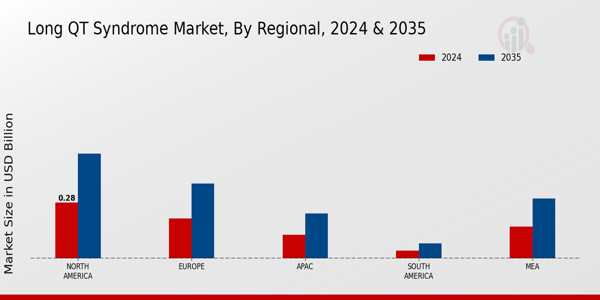Market Trends and Projections
The Global Long QT Syndrome Market Industry is characterized by several trends that indicate its future trajectory. The market is projected to grow from 0.8 USD Billion in 2024 to 1.5 USD Billion by 2035, reflecting a compound annual growth rate of 5.88% from 2025 to 2035. Key trends include the increasing focus on personalized medicine, advancements in diagnostic technologies, and the growing emphasis on patient education. These trends suggest a dynamic market landscape that is likely to evolve in response to emerging scientific discoveries and changing patient needs.
Advancements in Genetic Testing
Technological advancements in genetic testing are significantly influencing the Global Long QT Syndrome Market Industry. With the advent of next-generation sequencing, healthcare providers can now identify genetic mutations associated with Long QT Syndrome more efficiently. This capability not only aids in accurate diagnosis but also facilitates personalized treatment plans. As a result, the market is expected to grow, reaching an estimated value of 1.5 USD Billion by 2035. The increasing adoption of genetic testing in clinical settings is likely to enhance patient outcomes and drive demand for innovative therapies tailored to specific genetic profiles.
Development of Targeted Therapies
The ongoing development of targeted therapies for Long QT Syndrome is a significant driver of the Global Long QT Syndrome Market Industry. Pharmaceutical companies are investing in research to create innovative treatments that address the underlying genetic causes of the condition. These advancements are expected to enhance treatment efficacy and improve patient quality of life. As the market evolves, the introduction of new therapies is projected to contribute to a market value of 1.5 USD Billion by 2035. The focus on precision medicine is likely to reshape treatment paradigms and stimulate further investment in this area.
Regulatory Support for Drug Approvals
Regulatory support for the approval of new drugs targeting Long QT Syndrome is a vital driver for the Global Long QT Syndrome Market Industry. Regulatory agencies are increasingly recognizing the need for expedited pathways for therapies that address unmet medical needs. This support can significantly reduce the time required for new treatments to reach the market, thereby enhancing patient access to innovative therapies. As a result, the market is expected to witness a steady growth trajectory, with a projected value of 0.8 USD Billion in 2024. The favorable regulatory environment is likely to encourage pharmaceutical companies to invest in research and development.
Rising Prevalence of Long QT Syndrome
The increasing incidence of Long QT Syndrome is a primary driver for the Global Long QT Syndrome Market Industry. Recent estimates suggest that Long QT Syndrome affects approximately 1 in 2,500 individuals globally. This rising prevalence is likely to lead to heightened awareness and diagnosis, thereby expanding the market. As healthcare systems improve their screening processes, more cases are identified, contributing to the projected market value of 0.8 USD Billion in 2024. The growing patient population necessitates the development of targeted therapies and management strategies, which could further stimulate market growth.
Growing Awareness and Education Initiatives
The rise in awareness and educational initiatives surrounding Long QT Syndrome is a crucial factor propelling the Global Long QT Syndrome Market Industry. Organizations and healthcare providers are increasingly focusing on educating both medical professionals and the public about the condition. This heightened awareness leads to earlier diagnosis and treatment, which is essential for improving patient outcomes. As a result, the market is anticipated to experience a compound annual growth rate of 5.88% from 2025 to 2035. The emphasis on awareness campaigns is likely to foster a more informed patient population, ultimately driving market growth.






















Leave a Comment